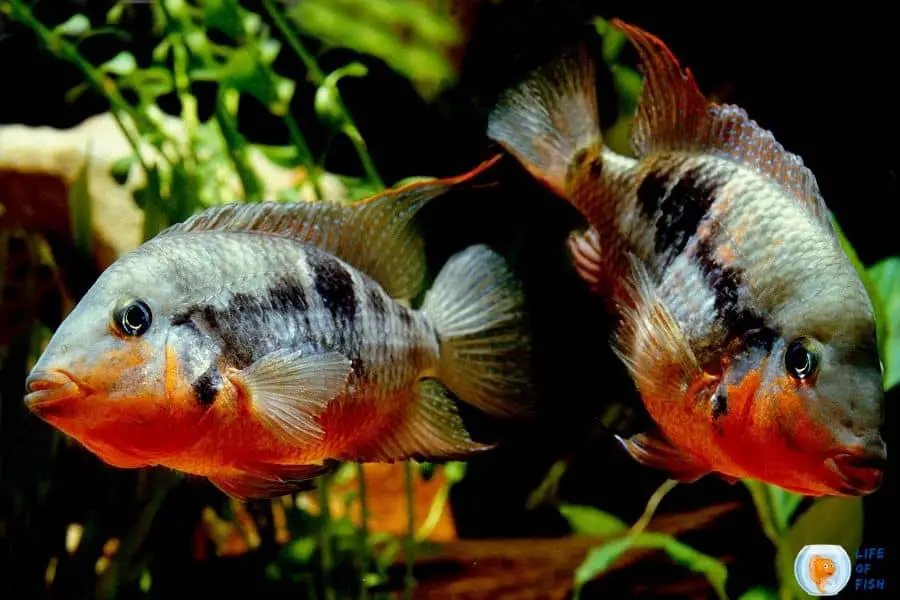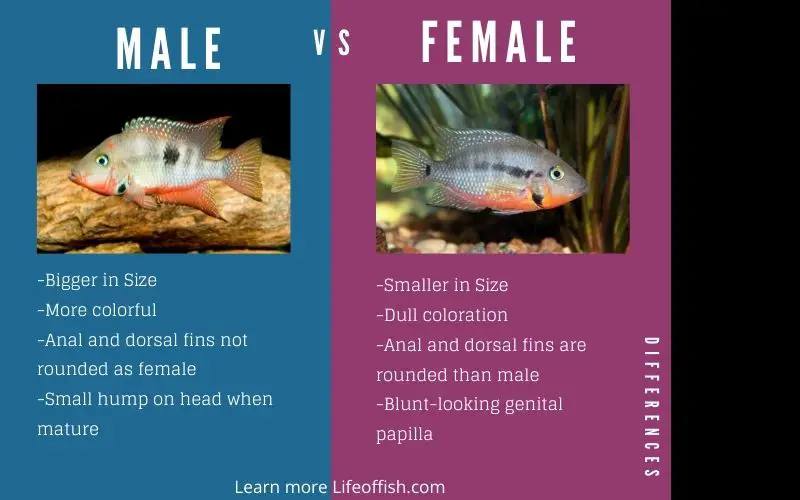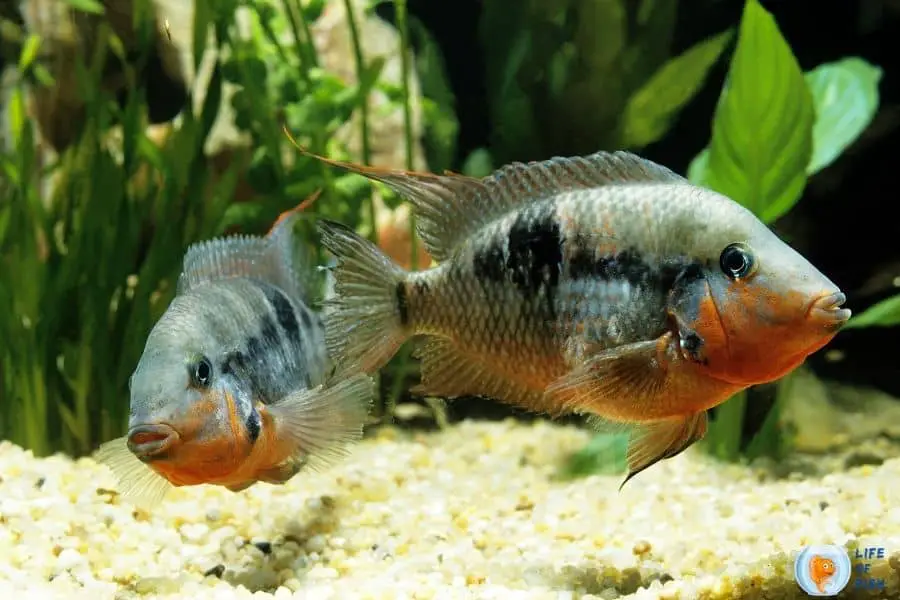Most hobbyists are unable to identify the firemouth cichlid female and male. So, sometimes they get confused about this. Firemouths are a striking fish variety that belongs to the Cichlid family. Their turquoise-blue backgrounds, red throats, red edging scales, and breasts are the main distinguishing factors. Due to this beautiful appearance, they attract most hobbyist attention. Also, they are known to be hardy and easy to care for.
So, I share my knowledge on identifying the male and female firemouth fish! Also, this include how to breed them. It is not hard. Indeed you may get the most beautiful experience after reading this guide!

How To Identify Firemouth Cichlid Female
Jump To
- 1 How To Identify Firemouth Cichlid Female
- 2 How To Identify Firemouth Cichlid Male
- 3 Is It Easy To Breed Firemouth Cichlid?
- 4 How To Treat Firemouth Female and male Cichlid In Separation
- 5 Preparation Of Breeding Tank
- 6 How to breed firemouth cichlids in the breeding tank
- 7 How They Lay Eggs And How How Firemouth Cichlid Eggs Look Like
- 8 What Should You Do After They Lay Eggs?
- 9 Taking Care Of Baby Firemouth Cichlid
- 10 Feeding Firemouth Cichlid
- 11 Perfect Water Parameters To Breed Firemouth Cichlid
- 12 How To Introduce Breeding Pair
- 13 Does Firemouth Cichlid Eat Their Eggs?
- 14 How Often Do Firemouth Cichlid Breed?
- 15 Firemouth Cichlid Mating Or Fighting?
- 16 Does Firemouth Cichlid Eat Their Babies?
- 17 Diseases, During The Breeding Season
- 18 Recently Asked Questions
- 19 Conclusion
If you are a Cichlid fan, you may know how hard to identify male and female fish from each other because many species exhibit little or no sexual dimorphism. Luckily Firemouth fish males and females can identify by their physical appearance. However, you have to wait until they mature because the young fishes do not show noticeable differences. The female Firemouth fish have slightly duller coloration than the males. Also, female fish have blunt-looking genital papilla.
This genital papilla is unique to female fish. To observe it, you have to observe the area under the belly. Just in front of the anal opening, you can see the genital papilla opening of female Firemouth fish. Further, if you look at the anal and dorsal fins of Firemouth females, those are rounded than male fish.
How To Identify Firemouth Cichlid Male
When compared with Firemouth females, male fish have bright coloration than females. However, rather than that, you can distinguish male Firemouth fish by observing anal and dorsal fins. The Male firemouth fish have more sharply pointed anal fins and dorsal fins. Moreover, male Firemouth has beautiful extended anal and dorsal fins. If you consider the mature group, the males are generally larger than females.

Is It Easy To Breed Firemouth Cichlid?
Yes, it is easy to breed Firemouth cichlid female and male in captivity. The mature fishes will naturally mate without any intervention from the aquarist. The high-quality diet and water condition are the main external parameters stimulating the breed. Rather than natural mating, you can use a proven mated pair for the breed. However, it will be challenging if you try to breed juvenile fish. Generally, the matured fish size range from 3-6 inches. Hence, the size is an excellent parameter to identify whether they are ready to breed or not.
How To Treat Firemouth Female and male Cichlid In Separation
Do you know how to choose Firemouth male and female fish for the breed? The best method for paring is, add six, eight juveniles in the same tank. Then, the firemouth cichlid will mate for life like most central American cichlids. Also, they love choosing who they pair off with. So, let them grow together and naturally pair off after they mature. Soon after they have paired off, breeding will normally begin. So, if you want to keep breeding pairs in a separate tank, remove them immediately after they pair out.
Preparation Of Breeding Tank
When preparing a breeding tank for firemouth cichlids, you have to pay attention to some important factors. Check the below list. These tools are essential to creating a good breeding environment for your fish.
Required tools and accessories
- 24-inch tank and hood (Minimum size)
- Aquarium light
- Water filter
- 100w heater
- Driftwood
- fine gravel or sand
- several flat stones/ slates and a clay plant pot
- potted plants
You should set up a breeding tank, including the above materials, to breed firemouth cichlids. It is important to replicate the natural environment of firemouth in the breeding tank. They love to dig up the fine sand substrate at the breeding season rate. That’s why you need to place potted plants, fine sand, gravel and driftwood in the breeding tank.
How to breed firemouth cichlids in the breeding tank
The male firemouth fish display fiery red coloration during the breeding season. It is the major reason they got this “firemouth” name. To breed firemouth and get the best result, follow these steps!
Step 1: Raise the group of six firemouth cichlids in the community tank
Add six, or eight juveniles in the same tank and raise them together
Step 2: Set a breeding tank with preferable environmental parameters
Temperature: The ideal temperature for rear firemouth cichlids is 77oF. Rice it to 82 oF to stimulate breeding.
Filtration system: Add sponge filter with a gentle flow. It will help to maintain the water quality. Also, help to aerate the breeding tank.
pH level: Maintain pH level at 7.2 or slightly higher in the breeding tank.
Hardness: Firemouth fishers prefer medium hardness. So keep water hardness below 10 dGH.
Substrates: Introduce plotted plants, fine sand, gravel and driftwood to the breeding tank.
Step 3: Then, Remove the most obvious “couple” from the breeding tank
Once your breeding tank is ready, introduce mated pairs into it. The firemouth male fish chases the female down and traps her. You should have at least 24 inches long take to breed fire mouths. However, if you have a much bigger tank, use it for breeding. The space can positively encourage fish to breed.
Step 4: Raise the temperature of the firemouth fish breeding tank to 82oF
You should fill the breeding tank with normal dechlorinated tap water.
Step 5: Condition the breeding pair by providing live foods several times a day
Step 6: Allow firemouth female fish lays eggs on the spawning site
The fertile firemouth female then starts to look for a place to lay the eggs. So, tank substrate will help them. They glide over each egg individually, one after the other. After that, the male firemouth fish will glide over the eggs and fertilise them.
Step 7: After the eggs hatch, do 10% water changes every day
Here, you should use aged water to add. Generally, after four days, these eggs will hatch. Then parents move to create a second nest for their babies. Usually, this secondary nest is a pit that firemouth cichlids dug in the gravel. Until they become free-swimming fry, firemouth parents look after them. Generally, they become a free-swimming stage on the 7th or 8th day. However, it depends on the breeding tank temperature. That’s why it is vital to maintain it at the correct level.
Step 8: Start feeding firemouth fry with life feed
The fry tends to swim out of the nest while the parents guard them. In this stage, please provide them with brine shrimp and micro worms. After the firemouth fry becomes three weeks old, give dried fish food. Do you want to increase the growth rate? So, give both live and dried feed to grow them fast.
Step 9: Remove the firemouth parents any time after the fry become a free-swimming stage
Step 10: Continuously feed free-swimming fish
Here, you can use both live and dried fish foods. Firemouth babies can eat powder foam of fish flakes and pellets. Keep in mind small fry fish unable to eat large food particles. So, provide fine foods.
Step 11: Done!
If you succeed, you will be the proud owner of hundreds of firemouth babies.
How They Lay Eggs And How How Firemouth Cichlid Eggs Look Like
Generally, female fire moth cichlids laid eggs on a flat surface. It can be flat rocks, broad leaves, decorations and driftwood. Also, some females lay eggs directly on the aquarium glass. Do you know how many eggs they lay at one spawn? They can lay 100- 500 eggs per one spawn. Here, the female fish laid several eggs in a line. Therefore eggs will not place on top of each other.
Like that, they lay hundreds of eggs per one spawn. Do you ever see the firemouth cichlids eggs? They are a tan color. After all the batches of eggs have been laid and fertilised, the male and female firemouth fish guard and eggs until they hatch. So, they clean and remove dead eggs from the collection during this period. It helps to avoid contaminating them on other eggs.
What Should You Do After They Lay Eggs?
The firemouth eggs can be infected with fungus. Thus, to prevent it, you can add a few drops of methylene blue after a female lays eggs. Methylene blue is a safe aquarium disinfectant. If I say it as a concentration, it is 3 ppm. So, add one tablespoon of methylene blue to 10 gallons of water. However, rather than it, there is a natural protection for the firemouth eggs. Constantly parents clean their eggs and remove spoiled ones.

Hatching Tank For Firemouth Cichlid Eggs; Is It Necessary?
No, it is not necessary. You can use the same breeding tank to hatch the firemouth’s eggs. Because the parent fish provide reasonable protection for their eggs. Thus, you do not worry about eggs’ health.
Taking Care Of Baby Firemouth Cichlid
Like every baby fish, firemouth also requires specific care to survive. Generally, the egg will hatch and release fry fish after a week. So, to maintain water quality at an optimum level, do a 10% water change every day. At the beginning of its life, a firemouth requires a good nutrient source. Also, this food should be matched with their mouth size.
Therefore, live food like brine shrimp and micro worms is ideal for feeding them. You can give them just after when they begin to swim. Rather than live food, you can give powder foam of dried fish feed to them after 3 weeks.
Feeding Firemouth Cichlid
Firemouths are also the same as all the other Cichlids. They are omnivores and have varied diet. But they mainly prefer carnivorous foods. It is vital to replicate a wild environment in captivity. Thus, you should ensure they get enough feed with a proper balance to grow well. So, here I listed some of the food that has quality nutrients. Add them to the firemouth fish diet to keep them healthy.
Protein Sources
Protein is the main factor that helps to keep your fish healthy and happy. Thus, add the below food to their diet.
- Live worms
- Small fish
- Mosquito larvae
- Small invertebrates
- Algae
Live food
Both firemouth juveniles and adults love to eat below mentioned live feeds.
- Bloodworms
- Tubifex Worms
- White worms
- Brine shrimp
- Daphnia
Small Crustaceans
- Cladocerans
- Small invertebrates
- Copepods
- Organic detritus
- Snails
Frozen Food
You can try frozen foam in the absence of live food.
Dried feed
- Fish flakes
- Pellets
Vegetables
As Firemouth cichlids are omnivorous can balance their diet with vegetables. Try the below-listed vegetables.
- Pieces of cucumber
- Blanched spinach
- Finely chopped spinach
How Often Should Firemouth Be Fed?
Add a small portion of food multiple times per day. If you are a beginner, add the amount that firemouth can eat within 3 minutes.
Perfect Water Parameters To Breed Firemouth Cichlid
Temperature: The ideal temperature for rear firemouth cichlids is 77oF. Rice it to 82 oF to stimulate breeding.
Filtration system: Add a sponge filter with a gentle flow. It will help to maintain the water quality. Also, help to aerate the breeding tank.
pH level: Maintain pH level at 7.2 or slightly higher.
Hardness: They prefer medium hardness. So keep water hardness below 10 dGH.
Substrates: Introduce plotted plants, fine sand, gravel and driftwood to the breeding tank.

How To Introduce Breeding Pair
After you prepare the breeding tank, catch the mated pair. Then add them into the breeding tank. Here, you should follow the acclimating process to minimize the fish’s stress level. So, collect breeding pairs using a net and add them into the small polythene bag. Then add community tank water into it.
Then placed that bag in the breeding tank. Allow it to float for 20 minutes in the breeding tank, and then let the fish adjust to water temperature. Finally, open the bag’s mouth and let the fish swim into the tank. Rather than the above method, you can directly catch breeding pairs and introduce them into the breeding tank. Do this with proper care.
Moving Grown-Up Firemouth Cichlid Into Bigger Tanks
Here also, you should do the acclimation steps. Also, you should ensure that bigger tank mates are compatible with firemouth babies. If not, they will become prey to bigger fishes.
Firemouth Cichlid Eggs Hatching Time
The Firemouth egg hatching period depends on tank temperature. Generally, it takes 4 days to hatch.
Does Firemouth Cichlid Eat Their Eggs?
Yes, they do. Generally, firemouth fish show parental care. Thus, until the eggs hatch, they clean and maintain them. So, when they notice any dead eggs, they eat them. It helps to keep other eggs healthy. But like many other cichlids species, it is unusual to see new parents eat their first few batches of eggs or fry.
How Often Do Firemouth Cichlid Breed?
The mature firemouth fish tend to breed several times per year. The number of spawning will depend on the other environmental conditions. Especially temperature is a key factor that stimulates them to breed.
Firemouth Cichlid Mating Or Fighting?
During the breeding season, firemouth fish circled each other side by side. They are also doing lots of lip-locking. Also, if they are in a community tank, mating pairs will show a bit of aggression towards other fish in the breeding season. Also, they like to flare their red gills and throat at other fish to protect themselves.
Does Firemouth Cichlid Eat Their Babies?
No, firemouth gives good parental care from the egg to the free-swimming stage. So, they do not eat their babies. But, after the eggs laid, they clean them and remove unfertilised eggs. So, some people misunderstand it as they eat their own babies.
Diseases, During The Breeding Season
Stress is the critical parameter that begins most diseases. So, keeping your fish happy is vital. The unbalance diet, feeding frequency, tank mates and poor water conditions directly influence the health of the fish. How is this related to breeding season? If you cannot provide sufficient nutrients in the breeding season, fish get weak. Also, if water quality parameters are not ideal, breeding pairs get sick. So, stressed fish are very susceptible to diseases.
Ich Disease
If you notice white spots on your fire mouths? Especially in the gill and fin region? Or else, is your fish loss of appetite? The reason is parasite causes ich. However, do not worry; Ich disease is relatively easy to treat. You just need to increase the tank temperature gradually for a few days. Then, if these signs disappear, it is no longer an issue.
Recently Asked Questions
Can You Breed Firemouth Cichlid In A Community Tank?
Yes, you can breed the firemouths in community tanks too. The tank size should have at least 48 inches to breed them successfully. A good space is essential to breed.
How Long Does It Take For Firemouth Cichlid Fry To Grow?
Firemouth cichlids are slow growers, and they took 4-5 years to reach their full size. However, they can grow up 2.5 inches on average within 6-7 months. However, the fish growth rate will depend on various factors. Therefore, there are some exceptions! It includes both the external and internal environment of fish.
Conclusion
Read Next : Firemouth Cichlid Tank Mates | 20 Companions For Them | Can You Guess Firemouth Cichlid Size? (Here Is The Answer!)

